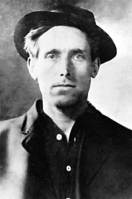On November 19th, 104 years ago, Joe Hill was executed by the State of Utah.
The young itinerant laborer was born Joel Emmanuel Hagglund in 1879. After emigrating from Sweden to the United States he took the name Joseph Hillstrom, then let it be shortened to Joe Hill. Working as a machinist and at various laboring jobs, he drifted his way West, where he joined the Industrial Workers of the World (I.W.W.).
While working on the West Coast, Joe Hill took popular songs of the day and inserted his own lyrics–satirical, irreverent, often humorous–commenting on the plight of the working class in America. The I.W.W. proved to be a perfect fit for Hill. A loose organization of young, rowdy itinerant workers in the woods and in the mines and on farms, factories, and wherever else cheap labor was sought, the “Wobblies” used songs and street corner oration to denounce the economic and political system they saw as being skewed against them. In “free speech” demonstrations, in cities such as Spokane and Portland, they let themselves be hauled off to jail in droves, driving their captors to distraction with their songs and antics.
In 1910, Joe Hill wrote “The Preacher and the Slave,” borrowing the melody from the hymn “In the Sweet By and By.” Also called “You Will Eat By and By,” it was sung on the corners of Burnside Street in Portland, Oregon. Copies were sold for 10 cents each. A verse ended with:
“Work all day, live on hay.
You’ll get pie in the sky when you die.”
Likely Hill didn’t know when he wrote that last line that he was coining a phrase soon to become commonplace in American speech.
On January 10th, 1914, A Salt Lake City grocer (a former policeman) named John G. Morrison and his son were murdered. Joe Hill went on trial for the crime, and was convicted–a chief piece of evidence being a bloodied red bandanna.
Though he had already begun making a name for himself as the unofficial songster for the I.W.W., he may not have achieved legendary status had not the State of Utah executed him by firing squad on November 19, 1915. While on trial for murder, unable to afford a capable defense counselor, Hill refused to properly defend himself, though the evidence against him was flimsy. He claimed there was a woman who could’ve proven his innocence, as he’d been with her at the time of the murder. But he refused to give her name. He claimed to be amorously involved with her and didn’t want to shame her, or embarrass her husband.
Among those who pleaded for Hill’s life was Helen Keller, the blind-deaf activist. The Swedish embassy in Washington, D.C., intervened to have him spared. President Woodrow Wilson requested the governor of Utah to postpone the execution, pending further examination of evidence. The request was denied.
The novelist Wallace Stegner grew up in Salt Lake City. He would’ve been six years old the year Joe Hill was executed. The story of the man himself and the legend his execution launched would’ve been part of the world in which Stegner grew up. In 1950 he published The Preacher and the Slave, a blending of fiction and historical fact that was unique at the time. Published by Doubleday, the title was changed to simply Joe Hill. The story captures the grit and struggle of the labor movement of the time, when the I.W.W. was reaching its peak. But as Stegner pointed out in a 1993 interview, when he was 82 years old, filling in details of Joe Hill’s life those five years leading up to his execution was a near-impossible challenge, considering the secretive existence the man led. So what isn’t verifiable as fact in the story comes out as fiction based on the probable.
A woman who falls in love with Joe at the time of his trial is central in the novel. Named Ingrid Olson, is she “the woman” who’s alibi could’ve saved him? Was she completely fictional? We don’t know, and never will. Another character in the story who is likely fictional, but probable, is Gus Lund, a preacher who runs the Scandanavian Seaman’s Mission in San Pedro. He become’s Hill’s confidante, and spends the last hours with Joe as they await the dawn in the grim confines of Utah’s Sugar House Prison–the dawn that will rise with the sound of simultaneously cracking rifles, as the firing squad in an instant carries out its assignment.
The event that launched the legend that hasn’t yet died. It survives not only as story, but in song–as sung by the likes of Paul Robeson and Joan Baez in “I Dreamed I Saw Joe Hill Last Night.”
In a 1993 interview, Wallace Stegner concedes that Joe Hill was probably guilty, but should never have been convicted, due to the flimsy evidence. When Stegner published a similar stance in the New Republic, back in 1948, there were many still-surviving Wobblies who cried foul. Legends don’t die easy. Whether or not Hill committed the murder will likely never be known. But even if Joe Hill was guilty, the sham trial itself would indicate that he was railroaded into being shot by the State of Utah, as an undesirable labor radical. And by all description it appears he faced death as a martyr. That in itself is the stuff of legend.


